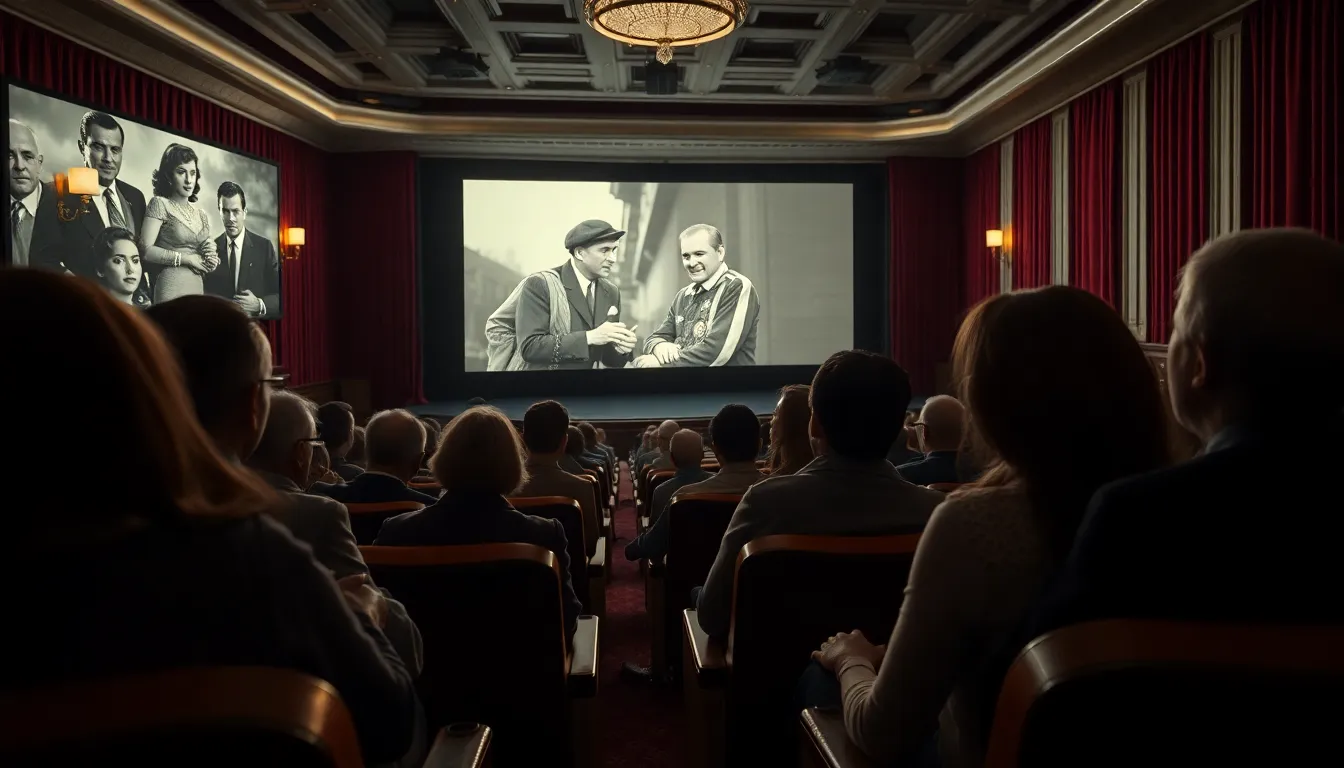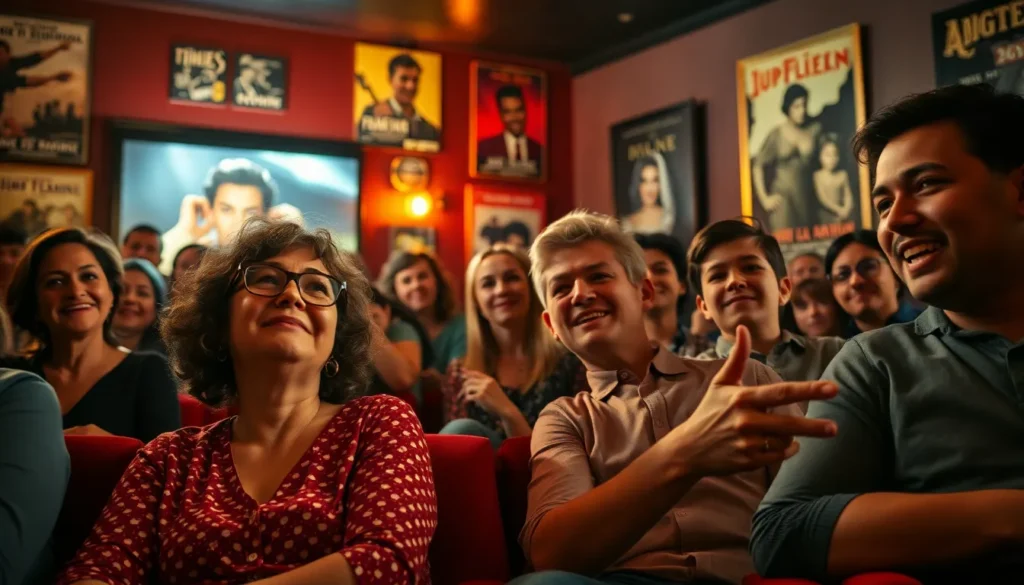Table of Contents
ToggleIn a world where streaming services bombard viewers with endless options, cinema retrospectives offer a refreshing escape into the past. They’re like a time machine for film lovers, whisking audiences away to relive the magic of classic films and forgotten gems. Picture this: popcorn in hand, surrounded by fellow cinephiles, as the screen lights up with iconic scenes that shaped the industry.
Understanding Cinema Retrospectives
Cinema retrospectives present a nostalgic experience for film lovers, showcasing classic films and hidden gems in a communal atmosphere. These events foster connections among audiences by celebrating the artistry of cinema.
Definition and Purpose
Cinema retrospectives serve to highlight significant films, directors, or movements from the past. Their primary purpose is to engage audiences with cinematic history by revisiting iconic works that shaped the industry. By offering screenings accompanied by discussions or expert insights, organizers deepen the appreciation for these films. Additionally, they create opportunities for viewers to form connections, share experiences, and discover new perspectives on beloved titles.
Historical Context
Historical cinema retrospectives began gaining traction in the late 20th century, as film festivals and art houses embraced this format. During this time, film enthusiasts sought to explore the evolution of cinema, leading to a rise in curated screenings that showcased influential directors like Alfred Hitchcock and Federico Fellini. Throughout the years, these events have adapted to include diverse genres, cultures, and movements. Their growth reflects a yearning among audiences to connect with cinematic legacies, keeping the magic of film history alive.
Notable Cinema Retrospectives

Cinema retrospectives showcase significant works, reviving interest in films from different eras. Several notable examples illustrate their impact on film culture.
Classic Film Retrospectives
Classic film retrospectives celebrate timeless movies and iconic directors, enhancing appreciation for cinema’s rich history. Major events often include screenings of groundbreaking works like Alfred Hitchcock’s masterpieces or Fellini’s enchanting narratives. These screenings create opportunities for discussions led by film scholars or critics, providing valuable context. Often, audiences experience these films in original formats, such as 35mm or even restored versions, which enhances the viewing experience. Institutions like the American Film Institute frequently host such retrospectives, reinforcing connections among film enthusiasts.
Contemporary Cinema Retrospectives
Contemporary cinema retrospectives highlight recent films and the directors shaping current cinematic trends. These retrospectives may focus on specific genres, innovative storytelling techniques, or significant festivals such as Sundance or Cannes. Screenings of critically acclaimed films and debuts from emerging filmmakers spark dialogue about evolving narratives and themes in cinema. Engaging with contemporary works ensures audiences remain connected to the dynamic landscape of film. Various venues, including local art houses and film festivals, often showcase these retrospectives, offering participants fresh perspectives on recent cinematic accomplishments.
The Impact of Cinema Retrospectives
Cinema retrospectives have a significant influence on film culture. These events deepen viewers’ understanding and appreciation of cinema’s history and artistry by showcasing essential works and iconic filmmakers.
Influence on Film Appreciation
Retrospectives spark interest in classic films. By screening influential titles, they illuminate groundbreaking storytelling techniques that shaped the industry. Discussions alongside screenings encourage audience engagement, highlighting the importance of context in understanding cinema’s evolution. Viewers often discover lesser-known gems, enriching their viewing experience and expanding their cinematic knowledge. Film experts and scholars frequently lead post-screening talks, offering insights that enhance appreciation for the craft. This communal aspect fosters conversations among attendees, creating connections that strengthen their bond with film. Ultimately, retrospectives play a vital role in raising awareness of cinematic artistry and history.
Role in Film Preservation
Film preservation remains a central aspect of cinema retrospectives. These events often utilize restored prints and original formats, allowing audiences to experience films as they were originally intended. Institutions like the American Film Institute invest in archival efforts, ensuring the longevity of significant films. By showcasing these restored works, retrospectives highlight the importance of maintaining cinematic heritage. Such events raise awareness about the challenges of film preservation in the digital age. This focus on preserving history ensures that future generations can appreciate classic cinema and learn from its impact on contemporary filmmaking. Engaging audiences with well-preserved films fosters a commitment to safeguarding cinema’s legacy.
How to Organize a Cinema Retrospective
Organizing a cinema retrospective involves several key steps to ensure a memorable experience. Engaging the audience proves crucial in connecting them with significant cinematic works.
Selection of Films
Choosing films requires a thoughtful approach. Consider the theme, director, or cinematic movement to highlight. Prioritize titles that resonate with audiences, balancing classics with lesser-known gems. Incorporate films that showcase groundbreaking techniques or significant cultural impacts. Often, selecting a mix of genres can enhance appeal. Research historical contexts to enrich discussions during screenings. Film experts can offer valuable insights into why specific films deserve inclusion. Ultimately, the selection process shapes the retrospective’s overall impact.
Curating the Experience
Crafting an immersive experience enhances viewer engagement. Begin by curating an inviting atmosphere for attendees. Incorporate elements such as themed decorations or curated playlists that complement the films. Facilitate discussions led by film scholars or experts post-screenings. Encourage audience participation to deepen their appreciation. Use restored prints or original formats for an authentic feel. Offering refreshments that relate to the films can also create a memorable experience. Attending to details fosters a communal atmosphere, allowing audiences to connect over shared cinematic experiences.
Cinema retrospectives serve as vital touchstones for film enthusiasts eager to explore cinematic history. They create unique spaces for collective viewing experiences that deepen appreciation for both classic and contemporary films. Through expert discussions and restored screenings, audiences connect with the artistry and innovation that define cinema.
These events not only celebrate the past but also pave the way for future generations to engage with film. By highlighting significant works and fostering community dialogue, cinema retrospectives ensure that the magic of storytelling continues to resonate. As the landscape of film evolves, these gatherings remain essential in preserving and honoring the rich tapestry of cinematic heritage.







